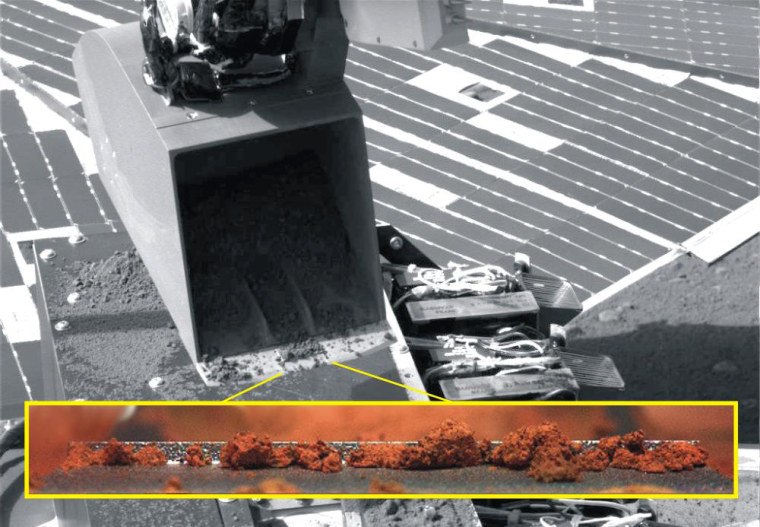NASA's Phoenix Mars Lander found evidence of mineral nutrients essential to life in Martian dirt, mission scientists announced Thursday.
After performing the first wet chemistry experiment ever done on another planet, Phoenix discovered that a sample of Martian dirt contained several soluble minerals, including potassium, magnesium and chloride. Though the data is preliminary, the results are very exciting, scientists said.
"We basically have found what appears to be the requirements for nutrients to support life," said Phoenix's wet chemistry lab lead, Sam Kounaves of Tufts University. "This is the type of soil you'd probably have in your backyard. You might be able to grow asparagus pretty well, but probably not strawberries."
Asparagus, which thrives in alkaline soil, would like the Martian dirt, which Phoenix measured to have a very alkaline pH of between eight to nine. Strawberries like more acidic soil, he said.
The finding comes a week after the lander discovered water ice in the same dirt.
On Wednesday, the probe placed a cubic centimeter sample of Martian dirt in its onboard wet chemistry laboratory for the first time. The lab, part of Phoenix's suite of instruments called the Microscopy, Electrochemistry and Conductivity Analyzer, or MECA, was designed to test Mars' dirt for salts, acidity, minerals and conductivity.
After mixing the dirt with water Phoenix brought from Earth in one of MECA's teacup-sized beakers, the instrument measured various characteristics of the solution to learn about the properties of the dirt.
MECA includes four beakers, each of which can be used only once. NASA says the inside of each beaker contains 26 sensors designed to study Red Planet material.
"We're making mud, we're stirring it up, we're measuring it with sensors," said Jet Propulsion Laboratory scientist Michael Hecht, team leader for the MECA instrument.
Habitable world
The new findings help fulfill Phoenix's main purpose: to search for signs that the Red Planet's northern polar regions could have supported life. The probe landed in the arctic plains of Mars May 25 for what is now expected to be a four-month mission. The lander is not equipped to find life itself.
Slideshow 12 photos
Month in Space: January 2014
The soluble mineral nutrients it found, and the dirt's hospitable pH level, are both promising signs. However, the MECA instrument is not able to test for organic compounds such as carbon, oxygen and nitrogen, which are also necessary for life as we know it.
"We did find basically that there's nothing about [the dirt] that would preclude life," Kounaves said. "In fact, it seems very friendly."
Though the dirt itself seems to be hospitable, Kounaves pointed out that the very top layer at the surface is exposed to high levels of harsh ultraviolet light that is damaging to organic compounds, so that layer of soil may not be able to support life.
"There could be microbes living meters and meters underground," he said. "They would be very happy."
Water ice
Phoenix also recently found another promising sign that this Mars environment could be habitable to life. In a major success last week, the probe photographed what scientists say must be water ice: a few bright crumbs that evaporated over four days from a trench in the ground.
The scientists think it's water, and not some other material such as carbon dioxide, because of the time frame over which it vaporized. The local temperatures are too warm for carbon dioxide to remain frozen for even one day, scientists said.
Launched in August 2007, Phoenix includes cameras, a scoop-tipped robotic arm, a weather station and ovens in addition to its wet chemistry lab.
The probe's oven instrument, the Thermal and Evolved Gas Analyzer, or TEGA, also recently completed an experiment in which it heated up a sample of Martian dirt to 1,000 degrees Celsius (1,832 degrees Fahrenheit). When the sample was heated, the instrument measured signs of water, which researchers think was probably emitted when minerals melted that contained chemically bound water. This water would have been bonded to other molecules in the minerals, rather than existing on its own in the dirt.
"This is the first time anybody's ever heated up part of a planet to such high temperatures," said William Boynton of the University of Arizona, lead scientist for TEGA. "When we heated up the sample we got some modest amounts of water vapor. This is what we were hoping to see."
Though further analysis is needed to determine the source of the water vapor for sure, "what we can say now is that the soil clearly has interacted with water in the past," he said.
The results of both the TEGA and MECA tests are showing scientists that it's possible Mars may indeed have hosted, or may be hosting, some form of life.
"Over time I've come to the conclusion that the amazing thing about Mars is not that it's an alien world, but that it's actually very Earthlike," Kounaves said.

